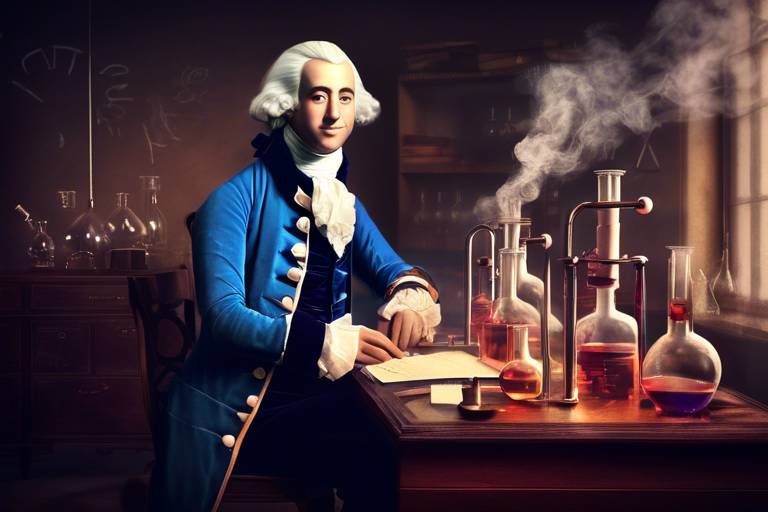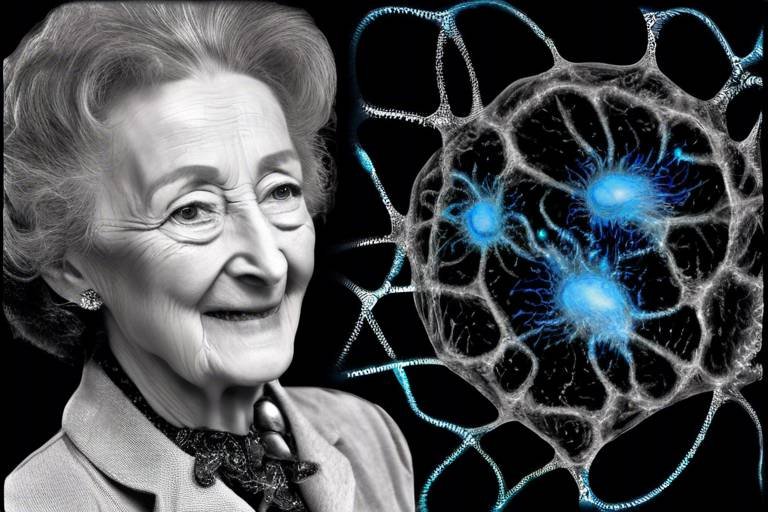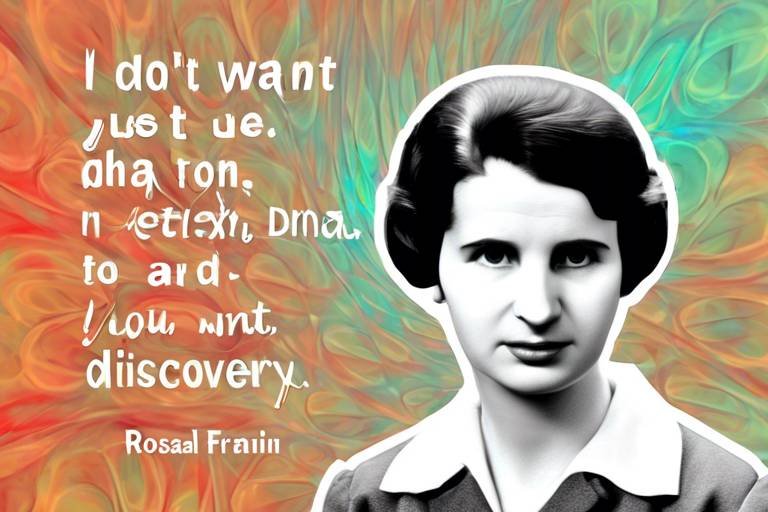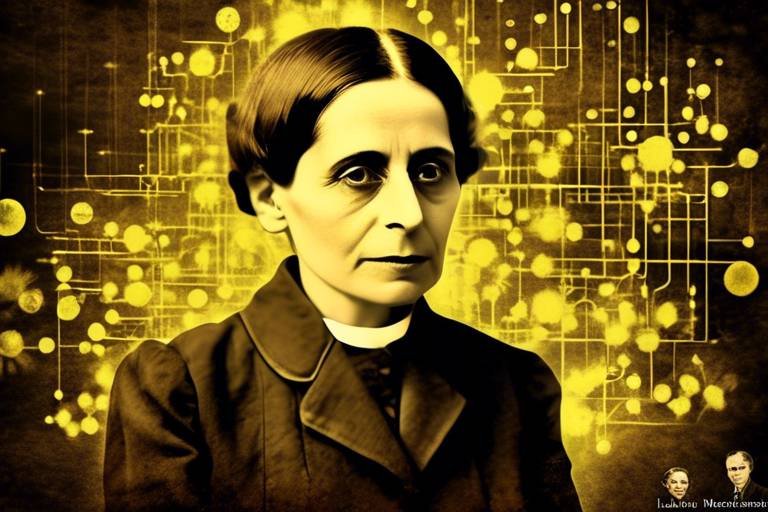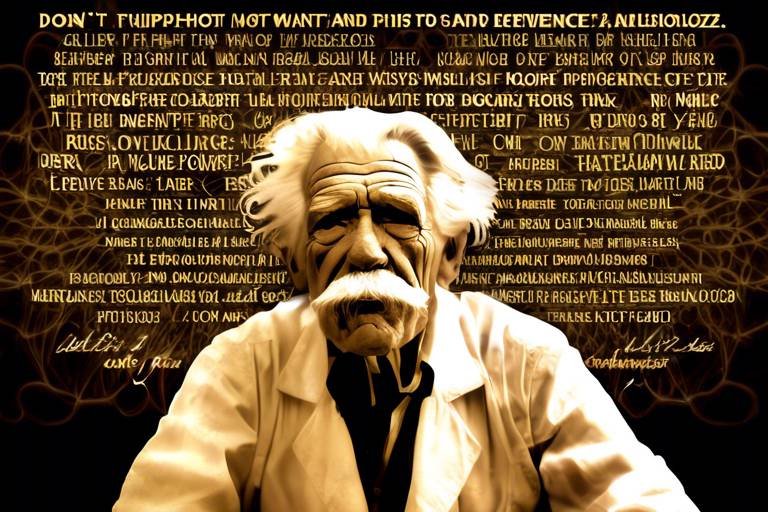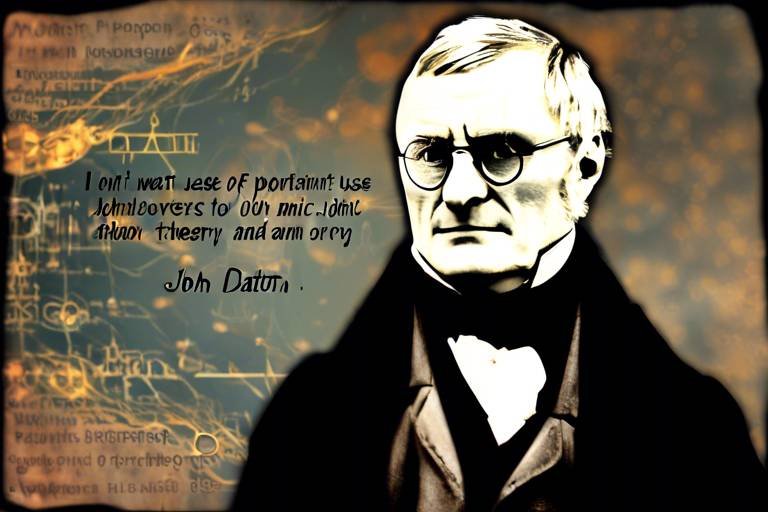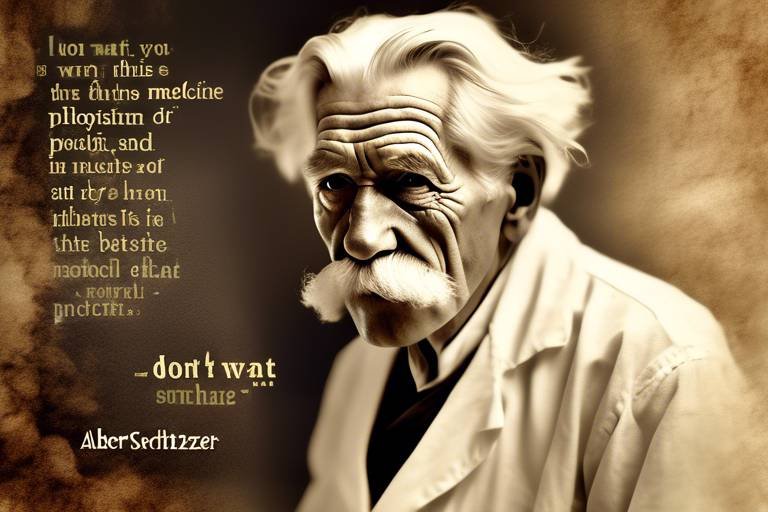The Life and Work of John Dalton in Chemistry
John Dalton, a name that resonates through the halls of chemistry, was a pioneering scientist whose contributions fundamentally shaped our understanding of matter. Born on September 6, 1766, in Eaglesfield, England, Dalton's journey into the world of science was not just a career choice; it was a calling. His early life was marked by a relentless curiosity about the natural world, which would eventually lead him to develop groundbreaking theories that are still integral to chemistry today. But what was it about Dalton's work that made such a lasting impact? Let’s dive deeper into the life and legacy of this remarkable figure.
Dalton grew up in a modest Quaker family, where education was highly valued. His father was a weaver, and young Dalton was expected to contribute to the family business. However, his passion for learning was undeniable. By the age of 12, he became a teacher, demonstrating his aptitude for science and mathematics. His early education was not formal; instead, it was filled with self-study and mentorship from local scholars. This blend of experience provided him with a strong foundation in scientific principles, which he would later expand upon.
Dalton's atomic theory emerged as a revolutionary concept in the early 19th century. Before his work, the idea of atoms was more philosophical than scientific. Dalton introduced a systematic approach to understanding matter, proposing that all substances are composed of tiny, indivisible particles called atoms. This was a radical shift in thinking, as it provided a concrete framework for understanding chemical reactions and compounds. Dalton's theory was not just a hypothesis; it was built on meticulous observations and experiments, which he documented with precision.
At the heart of Dalton's atomic theory are several key principles that changed the way scientists viewed the world. Here are the essential tenets:
- All matter is composed of atoms: Dalton posited that atoms are the smallest units of matter and cannot be created or destroyed.
- Atoms of the same element are identical: He suggested that all atoms of a given element are alike in mass and properties.
- Atoms combine in simple whole-number ratios: Dalton's law of multiple proportions stated that when elements combine, they do so in ratios of small whole numbers.
Dalton's atomic theory provided a robust framework for understanding chemical reactions. For the first time, scientists could explain why substances reacted the way they did. This theory clarified the nature of chemical compounds and the changes they undergo during reactions. Imagine trying to solve a puzzle without knowing the pieces; Dalton's work gave chemists the pieces they needed to understand the intricate dance of atoms during chemical transformations.
Despite its groundbreaking nature, Dalton's atomic theory was not without its critiques. Some scientists pointed out limitations, particularly regarding the indivisibility of atoms and the existence of isotopes. Over time, as new discoveries emerged, such as the electron and the nucleus, Dalton's theory was refined. However, it laid the groundwork for future explorations in atomic structure, proving that even the most revolutionary ideas can evolve.
In addition to his work on atomic theory, Dalton made significant contributions to the study of gases. His experiments led to the formulation of Dalton's Law of Partial Pressures, which states that in a mixture of non-reacting gases, the total pressure exerted is equal to the sum of the partial pressures of each gas. This principle is crucial for understanding how gases behave under different conditions. Dalton's meticulous observations and experiments in this area not only advanced the field of chemistry but also paved the way for future research in thermodynamics and physical chemistry.
Dalton’s work laid a solid foundation for modern chemistry, influencing countless scientists who followed. His atomic theory was a catalyst for the development of the periodic table, molecular theory, and the field of physical chemistry. The implications of his work extend far beyond the laboratory; they have shaped our understanding of everything from the composition of air to the principles of chemical engineering. It's hard to overstate the impact of his contributions—like a pebble thrown into a pond, the ripples of his discoveries continue to influence the scientific landscape today.
The legacy of John Dalton is deeply embedded in the fabric of chemistry. His contributions are celebrated in academic institutions around the world, and his name is often mentioned in textbooks that teach the fundamentals of chemistry. Dalton's work has not only been recognized in historical contexts but continues to inspire current research in atomic and molecular science.
Throughout his life, Dalton received numerous accolades for his contributions to science. He was elected a fellow of the Royal Society in 1822, and his work has been commemorated in various forms, including the naming of the Dalton unit of measurement for atomic mass. These honors reflect not only his personal achievements but also the profound impact of his work on the scientific community.
What was John Dalton's most significant contribution to chemistry?
Dalton's most significant contribution was his formulation of the atomic theory, which provided a systematic understanding of matter and chemical reactions.
How did Dalton's work influence modern science?
Dalton's work laid the groundwork for modern chemistry, influencing the development of the periodic table and molecular theory, as well as advancing the understanding of gases.
What honors did John Dalton receive during his lifetime?
Dalton was elected a fellow of the Royal Society and received various accolades recognizing his contributions to science, including the naming of the Dalton unit for atomic mass.

Early Life and Education
John Dalton was born on September 6, 1766, in a small village called Eaglesfield in England. Coming from a modest Quaker family, his early life was steeped in simplicity and hard work. The son of a weaver, Dalton was the third of six children, and his upbringing instilled in him the values of perseverance and curiosity. From a young age, he exhibited a profound interest in the natural world, often collecting specimens and conducting simple experiments. His thirst for knowledge was evident, even in a time when formal education was often a luxury.
Dalton's formal education began at a local Quaker school, where he was introduced to the fundamentals of mathematics and science. His teachers recognized his potential, nurturing his inquisitive mind. However, due to financial constraints, Dalton had to leave school at the age of 15. Instead of viewing this as a setback, he embraced the opportunity to become an apprentice to his brother, who was a schoolmaster. This experience allowed him to further his education by teaching others, which deepened his understanding of various scientific concepts.
Throughout his early career, Dalton remained committed to self-education, voraciously reading books on chemistry, physics, and mathematics. His passion for science led him to join the Manchester Literary and Philosophical Society, a hub for intellectual exchange. It was here that he connected with other thinkers and began to formulate his ideas about the nature of matter. Dalton's early influences, including the works of Isaac Newton and Robert Boyle, played a pivotal role in shaping his scientific outlook.
In 1793, Dalton became a teacher at a new school in Manchester, where he continued to cultivate his love for science. His interactions with students and fellow educators allowed him to share his knowledge and explore new ideas. Dalton's dedication to education and his relentless pursuit of knowledge laid the groundwork for his future discoveries in chemistry. The combination of his humble beginnings, formal education, and self-directed learning crafted a unique path for Dalton, ultimately leading him to become one of the most influential figures in the history of science.

Development of Atomic Theory
John Dalton's journey into the realm of atomic theory was nothing short of revolutionary. Imagine a world where the very building blocks of matter were shrouded in mystery, where the concept of atoms was merely a flicker in the minds of a few pioneering thinkers. Dalton stepped onto this stage with a vision that would change the landscape of chemistry forever. His atomic theory, introduced in the early 19th century, proposed that all matter is composed of tiny, indivisible particles called atoms. This idea was groundbreaking at a time when the nature of matter was poorly understood.
Dalton's theory emerged from a combination of scientific inquiry and personal curiosity. He was influenced by the works of earlier scientists like Antoine Lavoisier, who championed the law of conservation of mass, and Joseph Louis Gay-Lussac, whose studies on gas behavior laid the groundwork for Dalton's own experiments. Dalton meticulously observed and recorded data from his experiments, leading him to formulate the fundamental principles of atomic theory. He posited that atoms of different elements have different weights and that they combine in specific ratios to form compounds. This was a radical departure from the prevailing theories of the time, which often relied on philosophical speculation rather than empirical evidence.
To illustrate the essence of Dalton's atomic theory, consider the following key principles:
- All matter is made up of atoms: These atoms are indivisible and indestructible, forming the fundamental building blocks of matter.
- Atoms of the same element are identical: They share the same mass and properties, distinguishing them from atoms of other elements.
- Compounds are formed by the combination of different atoms: The ratio of atoms in a compound is fixed and can be expressed in whole numbers.
- In a chemical reaction, atoms are rearranged: While atoms may combine or separate, they are not created or destroyed.
These principles laid the groundwork for a new understanding of chemical reactions. Dalton's atomic theory provided a framework that clarified how substances interact at an atomic level. It offered a clear explanation of why certain elements combine in specific ways to create compounds, addressing questions that had puzzled scientists for centuries. For instance, Dalton's insights into the law of multiple proportions explained why elements like carbon and oxygen could combine in various ratios to form different compounds, such as carbon monoxide (CO) and carbon dioxide (CO2).
However, Dalton's atomic theory was not without its critiques. As the scientific community began to explore the atomic world further, some limitations of his theory became apparent. For example, Dalton's assertion that atoms are indivisible was challenged by the discovery of subatomic particles—electrons, protons, and neutrons—later in the 19th century. Additionally, the existence of isotopes, atoms of the same element with different masses, contradicted Dalton's idea that all atoms of an element are identical. Despite these limitations, Dalton's work was a vital stepping stone that paved the way for future advancements in chemistry.
In summary, Dalton's development of atomic theory was a pivotal moment in the history of science. It not only provided a clearer picture of the atomic structure of matter but also sparked a series of discoveries that would ultimately lead to the modern understanding of chemistry. His legacy is a testament to the power of scientific inquiry and the importance of questioning established beliefs. As we continue to explore the atomic world, Dalton's contributions remind us of the journey that science takes, often filled with surprises and revelations.

Key Principles of Dalton's Atomic Theory
John Dalton's atomic theory, proposed in the early 19th century, was a groundbreaking concept that changed the way scientists viewed matter. At its core, Dalton's theory introduced the idea that all matter is composed of indivisible particles known as atoms. This was a radical departure from previous notions that matter could be infinitely divided. Dalton's theory was built upon several key principles that not only explained the nature of matter but also laid the groundwork for future scientific inquiry.
One of the fundamental principles of Dalton's atomic theory is the assertion that all atoms of a given element are identical in mass and properties. This means that if you were to take any sample of a specific element, like oxygen or carbon, all the atoms within that sample would share the same characteristics. This idea helped to establish the concept of elements as pure substances, distinct from compounds that are formed when different elements combine.
Another significant principle is the concept of compounds. Dalton proposed that when atoms of different elements combine, they do so in fixed, whole-number ratios. For example, water (H2O) is composed of two hydrogen atoms and one oxygen atom. This notion of fixed ratios was a precursor to the development of chemical formulas and stoichiometry, which are essential in modern chemistry.
Dalton also introduced the Law of Multiple Proportions, which states that when two elements form more than one compound, the ratios of the masses of the second element that combine with a fixed mass of the first element can be expressed as small whole numbers. For instance, nitrogen and oxygen can form both nitrogen monoxide (NO) and nitrogen dioxide (NO2). The mass ratios of oxygen that combine with a fixed mass of nitrogen in these two compounds can be expressed in whole numbers, illustrating the predictable nature of chemical combinations.
These principles were revolutionary because they provided a systematic way to understand chemical reactions. Before Dalton, the nature of chemical interactions was largely speculative. His theory clarified that during a chemical reaction, atoms are neither created nor destroyed; they simply rearrange to form new substances. This concept is now a fundamental aspect of chemical science and is encapsulated in the law of conservation of mass.
However, while Dalton's atomic theory was groundbreaking, it wasn't without its limitations. For example, Dalton believed that atoms were indivisible, but later discoveries revealed that atoms are made up of even smaller particles, such as protons, neutrons, and electrons. Nevertheless, the essence of Dalton's theory—that matter is made up of discrete units—remains a cornerstone of chemistry.
In summary, Dalton's atomic theory introduced several key principles that revolutionized the field of chemistry. His ideas about the nature of atoms, the formation of compounds, and the behavior of elements in chemical reactions not only provided clarity but also set the stage for future scientific advancements. As we delve deeper into the world of chemistry, we can see the profound impact of Dalton's work, which continues to influence scientific thought and research today.

Implications for Chemical Reactions
John Dalton's atomic theory was nothing short of a game changer in the world of chemistry. It provided a robust framework for understanding chemical reactions, which are essentially the processes through which substances interact and transform into new substances. Before Dalton, the concept of matter and its transformations was a bit like trying to solve a puzzle without knowing what the picture looked like. But with his theory, the pieces started to fit together.
At the heart of Dalton's atomic theory is the idea that all matter is composed of indivisible atoms. This notion implies that during a chemical reaction, it’s not the atoms themselves that are created or destroyed; rather, they are simply rearranged. Think of it like a game of musical chairs where the chairs (atoms) don’t disappear, but the people (elements) simply change places. This understanding laid the groundwork for the law of conservation of mass, which states that mass is neither created nor destroyed in a chemical reaction.
Furthermore, Dalton's theory introduced the concept of chemical compounds being formed from specific combinations of atoms. This means that when different atoms come together, they do so in fixed ratios, leading to the formation of distinct substances. For example, when hydrogen and oxygen combine, they form water (H2O) in a specific ratio of 2:1. This principle of fixed proportions is crucial for predicting the outcomes of chemical reactions and is a cornerstone of modern chemistry.
Another significant implication of Dalton's atomic theory is the law of multiple proportions. This law states that when two elements form more than one compound, the ratios of the masses of one element that combine with a fixed mass of the other can be expressed in small whole numbers. For instance, carbon and oxygen can form both carbon monoxide (CO) and carbon dioxide (CO2). The mass ratios of oxygen in these compounds reveal a clear pattern, showcasing the orderly nature of chemical interactions as envisioned by Dalton.
In addition to these foundational concepts, Dalton's work prompted further exploration into the behavior of atoms during reactions, leading to the development of the modern periodic table and the understanding of atomic weights. His insights paved the way for future chemists to delve deeper into the intricacies of chemical bonding and reaction mechanisms. In essence, Dalton's atomic theory didn’t just explain how reactions occur; it opened up a whole new world of inquiry that continues to evolve today.
In summary, the implications of Dalton's atomic theory for chemical reactions were profound. By establishing that atoms are the building blocks of matter and that they interact in predictable ways, Dalton not only clarified the nature of chemical reactions but also set the stage for the vast field of chemistry that we know today. His ideas resonate throughout the scientific community, reminding us that understanding the fundamental building blocks of nature is key to unlocking the mysteries of the universe.
- What is Dalton's atomic theory?
Dalton's atomic theory posits that all matter is made of indivisible atoms, which combine in fixed ratios to form compounds.
- How did Dalton's work influence modern chemistry?
Dalton's work laid the foundation for understanding chemical reactions and paved the way for future discoveries in atomic structure and chemical bonding.
- What are the key principles of Dalton's atomic theory?
The key principles include the indivisibility of atoms, the conservation of mass, and the law of multiple proportions.

Critiques and Limitations
While John Dalton's atomic theory was revolutionary, it wasn't without its critiques and limitations. One of the primary criticisms was the notion of the atom as an indivisible particle. As scientists delved deeper into the atomic structure, they discovered that atoms are, in fact, composed of even smaller subatomic particles—protons, neutrons, and electrons. This revelation significantly challenged Dalton's original premise that atoms were the smallest units of matter. Can you imagine the surprise of scientists when they learned that there was more to the atom than Dalton had proposed?
Another limitation of Dalton's theory was its inability to account for the existence of isotopes—atoms of the same element that have different masses due to varying numbers of neutrons. Dalton had assumed that all atoms of a given element were identical in mass and properties, which is not the case. This oversight meant that his theory couldn't fully explain the complexities of elements found in nature.
Moreover, Dalton's work primarily focused on simple gases and their behaviors, leading to some gaps in understanding more complex chemical reactions. For instance, his law of multiple proportions, while groundbreaking, didn't address the molecular structure of compounds formed by these elements. This limitation became more apparent as chemists began to explore organic chemistry and the vast array of compounds that could be formed.
To summarize, the critiques and limitations of Dalton's atomic theory can be encapsulated in the following points:
- Indivisibility of Atoms: Later discoveries revealed that atoms are made up of smaller particles.
- Isotopes: Dalton's assumption of identical mass for atoms of an element was inaccurate.
- Complex Reactions: His work did not fully encompass the behavior of more complex chemical compounds.
Despite these critiques, it's essential to recognize that Dalton's contributions laid the groundwork for future advancements in chemistry. His atomic theory was a stepping stone that spurred further exploration and refinement of our understanding of matter. Just as a seed can grow into a towering tree, Dalton's ideas blossomed into a rich field of scientific inquiry that continues to evolve today.

Research on Gases
John Dalton's fascination with gases was not just a passing interest; it was a profound exploration that would change the way we understand the atmosphere around us. In the early 19th century, when science was still in its infancy regarding the study of gases, Dalton stepped up to the plate. He meticulously conducted experiments that revealed the behaviors and properties of gases, laying the groundwork for what we now term gas laws. His work was pivotal, as it allowed scientists to start viewing gases not merely as invisible substances but as entities that could be quantified and understood.
One of Dalton's most significant contributions to the study of gases was his formulation of the Law of Partial Pressures. This law states that in a mixture of non-reacting gases, the total pressure exerted is equal to the sum of the partial pressures of each individual gas. Imagine a party where each person contributes to the overall noise level; just like that, each gas contributes to the total pressure. This was a revolutionary idea that provided a clearer understanding of how gases interact with each other in various environments.
Dalton also explored the concept of gas solubility in liquids, which was crucial for understanding phenomena such as respiration and the behavior of gases in aquatic environments. He discovered that the amount of gas that dissolves in a liquid is proportional to the pressure of that gas above the liquid, a principle that is still taught in chemistry classes today. To illustrate this, consider a soda can: when you open it, the pressure decreases, and the carbon dioxide gas escapes, creating that delightful fizz. Dalton's insights into this behavior were groundbreaking.
Furthermore, Dalton published his findings in a series of papers, most notably in his work titled “A New System of Chemical Philosophy”. This publication not only detailed his atomic theory but also included his extensive research on gases, solidifying his reputation as a pioneer in the field. His experiments were characterized by rigorous methodology, and he often used a variety of instruments to measure gas volumes and pressures, which was quite innovative for his time.
In addition to his theoretical contributions, Dalton’s research had practical implications. His understanding of gases paved the way for advancements in various fields, including meteorology, where the behavior of gases in the atmosphere is crucial for weather prediction. Today, we owe much of our knowledge about gases to Dalton’s early explorations, which set the stage for future scientists like Avogadro and Boyle to further expand upon his ideas.
To summarize, John Dalton's research on gases was a cornerstone of modern chemistry. His ability to connect theory with practical experimentation not only advanced our understanding of gases but also influenced various scientific disciplines. As we breathe in the air around us, we can thank Dalton for helping to decode the complexities of the invisible world of gases.

Impact on Modern Chemistry
John Dalton's contributions to chemistry were nothing short of revolutionary, and they set the stage for the modern understanding of matter and its interactions. His atomic theory, which proposed that all matter is composed of atoms—indivisible and unique to each element—transformed the scientific landscape. Imagine trying to build a house without a blueprint; that's how chaotic chemistry was before Dalton's time. His theory provided that much-needed blueprint, allowing scientists to explore the microscopic world with a new perspective.
Dalton's work laid the groundwork for many fundamental concepts that we take for granted today. For instance, his introduction of the idea that atoms of different elements have different weights helped establish the importance of atomic mass. This was a game changer! It led to the development of the periodic table, which organizes elements based on their atomic structure and properties. Without Dalton, who knows how long it would have taken for scientists to grasp the relationships between elements?
Moreover, Dalton's research on gases, particularly his formulation of the law of partial pressures, provided insights that are still relevant in fields like meteorology and engineering. His findings on how gases behave under various conditions have helped shape our understanding of everything from weather patterns to the design of modern engines. It’s fascinating to think that something as simple as a balloon’s inflation can be traced back to Dalton’s principles!
In the classroom, Dalton's legacy can be seen in how chemistry is taught. Students today learn about atomic theory and molecular structures as fundamental concepts, often without realizing the historical context behind them. Dalton’s work is a staple in educational curricula, ensuring that future generations appreciate the importance of scientific inquiry and discovery.
To illustrate the profound impact of Dalton's work, we can look at the following table that summarizes key advancements in chemistry influenced by his theories:
| Advancement | Description | Influenced By |
|---|---|---|
| Periodic Table | A systematic arrangement of elements based on atomic structure. | Dalton's atomic theory |
| Gas Laws | Understanding of how gases behave under different conditions. | Dalton's research on gases |
| Molecular Theory | Concept that compounds are formed from combinations of atoms. | Dalton's principles of atomic combinations |
In essence, Dalton's atomic theory didn't just influence chemistry; it sparked a chain reaction that led to the development of various scientific disciplines. His ideas paved the way for future scientists, such as J.J. Thomson and Ernest Rutherford, who expanded upon Dalton's groundwork to explore atomic structure and radioactivity. Each new discovery has built upon the foundation Dalton laid, creating a rich tapestry of scientific progress.
As we reflect on the impact of Dalton's work, it’s clear that his contributions are woven into the very fabric of modern chemistry. His legacy continues to inspire scientists and students alike, reminding us that curiosity and a quest for knowledge can lead to groundbreaking discoveries. After all, every great journey begins with a single step, and Dalton's journey changed the course of science forever.
- What was John Dalton's main contribution to chemistry?
Dalton is best known for his atomic theory, which proposed that all matter is made up of indivisible atoms. - How did Dalton's work influence the periodic table?
His idea that elements have distinct atomic weights helped establish the organization of elements in the periodic table. - What are gas laws, and how did Dalton contribute to them?
Gas laws describe how gases behave under various conditions. Dalton formulated the law of partial pressures, which is fundamental to understanding gas mixtures. - Why is Dalton’s atomic theory still relevant today?
Dalton's atomic theory laid the foundation for modern chemistry, influencing countless scientific advancements and educational practices.

Legacy in Scientific Community
John Dalton's contributions to chemistry are not just footnotes in a textbook; they are the very foundation upon which modern chemistry stands. His pioneering work on atomic theory has left an indelible mark on the scientific community, influencing countless researchers and educators alike. Imagine a world where the concept of atoms did not exist—how different our understanding of matter and chemical reactions would be! Dalton's ideas, which were once revolutionary, are now fundamental principles taught in classrooms around the globe.
One of the most significant aspects of Dalton's legacy is how it paved the way for future scientists. His atomic theory introduced the notion that all matter is composed of tiny, indivisible particles. This concept not only challenged existing beliefs but also opened up new avenues for research. For example, the work of subsequent chemists, such as J.J. Thomson and Ernest Rutherford, built upon Dalton's foundation, leading to the discovery of subatomic particles and the development of the modern atomic model.
Furthermore, Dalton's influence extends beyond just atomic theory. His meticulous approach to scientific experimentation and data collection set a standard for future research methodologies. He was one of the first to use quantitative methods in chemistry, which encouraged a more systematic approach to scientific inquiry. This shift in perspective can be seen in the way contemporary scientists conduct experiments, emphasizing the importance of accuracy and reproducibility.
Dalton's legacy is also evident in the way his work is integrated into modern scientific education. His theories are not merely historical anecdotes; they are actively taught in schools and universities, ensuring that new generations of scientists understand the significance of his contributions. In fact, many educational institutions honor Dalton's memory by naming laboratories and scholarships after him, serving as a continual reminder of his impact on the field.
In recognition of his groundbreaking work, Dalton has been commemorated in various ways. For instance, Daltonism, a term used to describe color blindness, is named after him due to his own struggle with the condition. This connection adds a personal touch to his legacy, reminding us that even great scientists are human and face their own challenges.
In summary, John Dalton's legacy in the scientific community is profound and far-reaching. His theories not only transformed the field of chemistry but also established a framework that continues to guide scientific research and education today. As we delve deeper into the mysteries of matter, we owe a great deal to Dalton for lighting the way.
- What is John Dalton best known for?
John Dalton is best known for his development of atomic theory, which proposed that all matter is composed of indivisible atoms.
- How did Dalton contribute to the study of gases?
Dalton made significant contributions to the understanding of gas laws, particularly with his work on partial pressures and the behavior of gases.
- What impact did Dalton's work have on modern science?
Dalton's work laid the groundwork for modern chemistry and has influenced many scientific advancements, including the understanding of chemical reactions and the development of the periodic table.
- Why is Daltonism named after John Dalton?
Daltonism is named after John Dalton because he was one of the first to study color blindness scientifically, as he himself was color blind.

Recognition and Honors
Throughout his life, John Dalton received numerous accolades that reflected his profound impact on the field of chemistry. His pioneering work laid the groundwork for modern atomic theory, earning him a revered place in the scientific community. One of the most significant recognitions came in the form of membership in prestigious societies. Dalton was elected a Fellow of the Royal Society in 1822, a testament to his innovative contributions and the respect he garnered among his peers. This honor is not just a badge of distinction; it symbolizes the recognition of his relentless pursuit of knowledge and understanding in the realm of chemistry.
Moreover, Dalton's work on color blindness, a condition he himself had, brought him additional recognition. His research led to the term "Daltonism," which is still used today to describe this visual impairment. This unique intersection of personal experience and scientific inquiry not only showcased his dedication but also highlighted the importance of understanding human biology in the context of chemistry. It’s fascinating how his life experiences enriched his scientific endeavors, making his contributions even more relatable and impactful.
In addition to his memberships and honors, Dalton's legacy is celebrated in various ways. For instance, several institutions and awards have been named in his honor, ensuring that future generations continue to recognize his contributions. For example, the Dalton Medal is awarded to chemists who have made significant contributions to the field, perpetuating his spirit of innovation. Furthermore, his birthplace in Eaglesfield, England, is now home to a museum dedicated to his life and work, serving as a reminder of his enduring influence.
Dalton's recognition extends beyond his lifetime; his theories are foundational in chemistry curricula worldwide. His name graces textbooks and academic discussions, ensuring that students and researchers alike appreciate the significance of his work. In a sense, Dalton's legacy is not just about the honors he received but also about how his ideas continue to shape the scientific landscape today.
In summary, John Dalton's recognition and honors are a reflection of his monumental contributions to chemistry and science as a whole. From his election to the Royal Society to the ongoing acknowledgment of his work in educational settings, Dalton's influence remains a vibrant part of the scientific narrative. His journey from a curious child to a celebrated scientist serves as an inspiration for aspiring chemists and scientists everywhere.
- What is John Dalton best known for?
John Dalton is best known for developing the atomic theory, which posits that all matter is composed of indivisible atoms. He also made significant contributions to the study of gases and color blindness.
- What honors did John Dalton receive during his lifetime?
Dalton was elected a Fellow of the Royal Society in 1822 and received various accolades for his work in chemistry and his research on color blindness.
- How has Dalton's work influenced modern chemistry?
Dalton's atomic theory laid the foundation for later scientific advancements, influencing the development of chemistry as a discipline and shaping our understanding of chemical reactions and compounds.
- What is Daltonism?
Daltonism refers to color blindness, a condition that John Dalton himself had. His research on this topic helped raise awareness and understanding of the condition.
Frequently Asked Questions
- What is John Dalton known for in chemistry?
John Dalton is best known for developing the atomic theory, which proposed that all matter is composed of indivisible atoms. His work laid the groundwork for modern chemistry by explaining how atoms combine to form compounds and how they participate in chemical reactions.
- How did Dalton's atomic theory change the scientific community?
Dalton's atomic theory revolutionized the way scientists understood matter. By introducing the idea that atoms are the basic building blocks of all substances, he shifted the focus of chemistry from qualitative descriptions to a more quantitative, systematic approach, paving the way for future discoveries.
- What are the key principles of Dalton's atomic theory?
Dalton's atomic theory includes several key principles:
- All matter is made up of tiny, indivisible particles called atoms.
- Atoms of the same element are identical in mass and properties.
- Atoms of different elements can combine in simple whole-number ratios to form compounds.
- In a chemical reaction, atoms are rearranged but not created or destroyed.
- What were some critiques of Dalton's atomic theory?
While groundbreaking, Dalton's atomic theory faced critiques, especially regarding its assumption that atoms are indivisible. Subsequent discoveries revealed subatomic particles, such as protons, neutrons, and electrons, which contradicted Dalton's original premise. Additionally, the theory did not account for isotopes, which are atoms of the same element with different masses.
- How did Dalton contribute to the study of gases?
Dalton made significant contributions to the understanding of gases, particularly through his formulation of the law of partial pressures. He conducted experiments that led to a better understanding of gas behavior and established that the total pressure exerted by a mixture of gases is equal to the sum of the partial pressures of each individual gas in the mixture.
- What is John Dalton's legacy in modern chemistry?
John Dalton's legacy is profound; his atomic theory is still taught in schools today and serves as a fundamental concept in chemistry. His insights have influenced countless scientists and have been critical in the development of various fields, including physical chemistry and molecular biology.
- What honors did John Dalton receive during his lifetime?
Throughout his life, Dalton received numerous accolades for his contributions to science, including being elected a fellow of the Royal Society. He was also honored with various awards and recognitions from scientific institutions, highlighting the lasting impact of his work on the field of chemistry.



